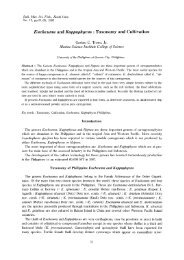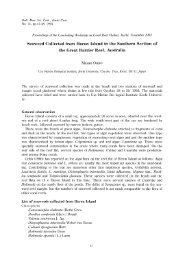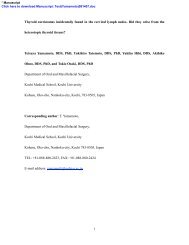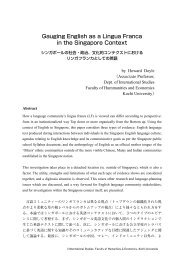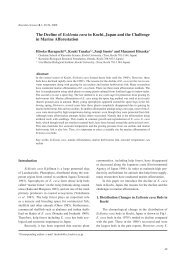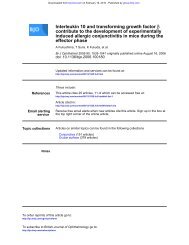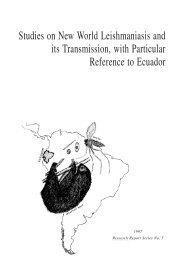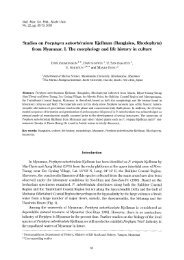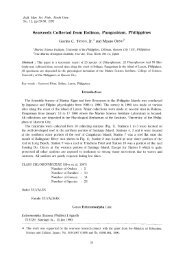48Ryoichi DOI, Pongsak SAHUNALU, Chongrak WACHRINRAT, Sakhan TEEJUNTUK and Katsutoshi SAKURAIof the variation, respectively. The sample groups were differentiated by the first PC axis. The second PC axis separated theBG sampl<strong>in</strong>g po<strong>in</strong>ts <strong>in</strong> the ord<strong>in</strong>ation space. On the other hand, an ambiguous separation was seen for the DEF replicates.Load<strong>in</strong>gs on the first axis for mixtures 1 and 2 were -0.938 and -0.865, while that for streptomyc<strong>in</strong>, sulfamethoxazole,tetracycl<strong>in</strong>e and trimethoprim were 0.703, -0.376, 0.918 and 0.670. The data did not support the hypothesis that the averageof the load<strong>in</strong>gs for the mixed antibiotics nearly equals the load<strong>in</strong>g for the mixture.At all the AWCD values <strong>in</strong> the Biolog method, the first and second PCs expla<strong>in</strong>ed around 50% of the variation. In all ofthe PC score plots (Fig. 4c, d, e, f), the <strong>soil</strong> sample groups from the BG and the DEF were separated by the first PC axes.The replicates for each vegetative type tended to be separated by the second PC axis until the AWCD value reached to 1.0,but the separation became ambiguous when the AWCD values reached to 1.4.Fig4,Table2Wilk’s lambda statisticThe antibiotic methods (methods 1 and 2) showed discrim<strong>in</strong>atory power comparable to that of the Biolog method, scor<strong>in</strong>glow values of Wilk’s lambda (Table 2). The discrim<strong>in</strong>atory power of the Biolog method decreased once dur<strong>in</strong>g the colordevelopment, but was restored dur<strong>in</strong>g the convergence stage.RDA ord<strong>in</strong>ation diagramsRDA ord<strong>in</strong>ation diagrams <strong>in</strong> Fig. 5 <strong>in</strong>dicate relationships between the <strong>bacterial</strong> <strong>profiles</strong> and the <strong>soil</strong> environmental factors.Only the significant environmental factors at p=0.05 and p=0.1 are shown, as solid and broken arrows, respectively. Nomulti-col<strong>in</strong>earity was detected among the environmental factors. All the pairs of axes were significant at p=0.01 accord<strong>in</strong>g tothe Monte Carlo permutation test. Method 1 resulted <strong>in</strong> Fig. 5a, <strong>in</strong>dicat<strong>in</strong>g that <strong>soil</strong> moisture content is the most significant<strong>soil</strong> environmental factor related to the MPN <strong>profiles</strong>. The DEF <strong>soil</strong> was expla<strong>in</strong>ed by its relatively high moisture content.Eigenvalues for the first and second axes were 0.401 and 0.074, respectively. Method 2 gave another pattern of RDAord<strong>in</strong>ation. Us<strong>in</strong>g method 2, <strong>soil</strong> moisture content and TN were specified to be the significant environmental factors relatedto the <strong>soil</strong> <strong>bacterial</strong> <strong>profiles</strong> (Fig. 5b). Two replicates of the BG <strong>soil</strong> were located far from each other, and the replicates ofthe DEF <strong>soil</strong> were also. Eigenvalues for the first and second axes were 0.675 and 0.046.Fig5Diagrams given by the Biolog method differed among the AWCD values. At an AWCD of 0.2, <strong>soil</strong> moisture content andC/N were significant environmental factors related to the Biolog <strong>profiles</strong> of the <strong>bacterial</strong> communities (Fig. 5c). Eigenvaluesfor the first and second axes were 0.590 and 0.078, respectively. At an AWCD of 0.6, <strong>soil</strong> moisture and TN contents weresignificantly related to the <strong>profiles</strong> of the <strong>bacterial</strong> communities at p=0.05, and BD was a marg<strong>in</strong>ally significantenvironmental factor (0.05 < p < 0.10, Fig. 5d). Eigenvalues for the first and second RDA axes were 0.540 and 0.072,respectively. At an AWCD of 1.0, pH was the significant environmental factor related to the <strong>profiles</strong> at p=0.05 (Fig. 5e).Eigenvalues for the first RDA axis decreased to 0.369, and that for the second axis was 0.085. At an AWCD of 1.4, <strong>soil</strong>moisture and TN contents were significantly related to the <strong>bacterial</strong> <strong>community</strong> <strong>profiles</strong> (Fig. 5f). The eigenvalue for the firstRDA axis <strong>in</strong>creased to 0.411, and that for the second RDA axis was 0.068. The BG samples were far from each other <strong>in</strong> theord<strong>in</strong>ation diagram at an AWCD of 0.2 (Fig. 5c), and the distance gradually decreased as the color development proceeded,while the DEF samples showed the reverse trend.In each diagram, the degradation gradient was expla<strong>in</strong>ed by the first axis, which scored an eigenvalue at least 4 timeslarger than the second axis. This <strong>in</strong>dicates that deforestation was the most significant source of the variation of <strong>soil</strong> <strong>bacterial</strong><strong>community</strong> <strong>profiles</strong>. Soil moisture content, pH, TN and BD related to <strong>soil</strong> <strong>bacterial</strong> <strong>community</strong> <strong>profiles</strong>, reflect<strong>in</strong>g thedegradation gradient. For the data set <strong>with</strong> an AWCD of 0.2, the C/N ratio was a significant source of variation of <strong>soil</strong><strong>bacterial</strong> <strong>community</strong> <strong>profiles</strong>, not along <strong>with</strong> the degradation gradient (Table 1).DISCUSSIONAnthropologic land degradation may affect s<strong>in</strong>gle or multiple <strong>soil</strong> environmental factor(s). Heavy metal contam<strong>in</strong>ation isrelatively well documented as a s<strong>in</strong>gle primary cause of changes as reflected by antibiotic resistance <strong>profiles</strong> (e.g., Roane &Kellogg 1996), sole carbon source utilization <strong>profiles</strong> (e.g., Kelly & Tate 1998) or biotic molecular <strong>profiles</strong> (Frostegård et al.1993) of <strong>soil</strong> microbial communities. The <strong>soil</strong> degradation follow<strong>in</strong>g deforestation also <strong>in</strong>volves changes <strong>in</strong> multiple <strong>soil</strong>environmental factors (Table 1). Deforestation result<strong>in</strong>g <strong>in</strong> multiple <strong>soil</strong> environmental changes also resulted <strong>in</strong> changes <strong>in</strong><strong>bacterial</strong> population structure (Doi & Sakurai, 2003), pattern of sole carbon source utilization by <strong>soil</strong> microbes (Staddon et al.
Soil <strong>bacterial</strong> communities reflect<strong>in</strong>g land degradation491997) and microbial molecular distribution pattern (Borneman & Triperett, 1997). In these cases, the relationships betweenthe altered <strong>soil</strong> environmental factors and the changes <strong>in</strong> <strong>soil</strong> microbial <strong>profiles</strong> are complicated.It has been recognized that particular environmental changes alter the multivariate <strong>profiles</strong> of <strong>soil</strong> microbialcommunities. Some <strong>soil</strong> environmental changes <strong>in</strong>volved <strong>in</strong> deforestation and <strong>soil</strong> degradation are thought to stress liv<strong>in</strong>gth<strong>in</strong>gs (Giuffre et al. 2001; Sakurai et al. 1998). In the SERS, the drier condition <strong>in</strong> the BG <strong>soil</strong> was suggested to be the mostsignificant factor reduc<strong>in</strong>g number of <strong>bacterial</strong> cells (Table 1) and diversity of the <strong>soil</strong> <strong>bacterial</strong> <strong>community</strong> (Doi & Sakurai2003). The drier <strong>soil</strong> condition <strong>in</strong> the BG <strong>soil</strong> may make it hard for some <strong>soil</strong> bacteria to survive, while may not effect others(Kilbertus & Proth 1979). The difference <strong>in</strong> <strong>soil</strong> moisture content was likely to be the ma<strong>in</strong> <strong>soil</strong> environmental factordifferentiat<strong>in</strong>g the <strong>profiles</strong> (Fig. 5, Doi & Sakurai 2003).A selective force was perhaps a source of variation <strong>in</strong> the <strong>soil</strong> <strong>bacterial</strong> <strong>community</strong> profile <strong>in</strong> the SERS. The low numberof <strong>soil</strong> <strong>bacterial</strong> cells <strong>in</strong> the BG <strong>soil</strong> (Table 1) suggests the importance of a selective force. Another possibly important factoris the change <strong>in</strong>side of <strong>bacterial</strong> cells <strong>in</strong> response to environmental changes. Some environmental changes have been shownto alter <strong>bacterial</strong> phenotypes such as culturability (Arana et al. 1992) and antibiotic resistance (McInroy et al., 1996) andgenotypes such as carbon source utilization (Velkov, 1999) and antibiotic resistance (Pote et al. 2003). These possibly relatedmechanisms need to be <strong>in</strong>vestigated.Land degradation has various aspects (Mausbach & Seybold, 1998). It is thought to be worth analyz<strong>in</strong>g these differentaspects <strong>with</strong> a multivariate strategy (Sena et al., 2000). The aspects <strong>in</strong>vestigated <strong>in</strong> this research are thought to reflect<strong>in</strong>dependently <strong>in</strong>volved events <strong>in</strong> the degradation (Fig. 5). The resistance of bacteria to particular antibiotics was shown tohave l<strong>in</strong>kages to the possible environmental stresses <strong>in</strong> the BG <strong>soil</strong> such as acidity (Ramos et al. 1987) or high temperature(Pillai and Pepper, 1991). A difference <strong>in</strong> above ground vegetation resulted <strong>in</strong> a variation of sole carbon source utilizationpatterns revealed by characteriz<strong>in</strong>g the <strong>soil</strong> <strong>bacterial</strong> isolates (Westover et al., 1998). The sole carbon source utilizationprofile of <strong>bacterial</strong> isolates may be altered when the cell encounters particular environmental stresses (Velkov, 1999). Suchl<strong>in</strong>kages between environmental factors and cells are thought to occur <strong>in</strong>dependently <strong>in</strong> the degradation.The Biolog method profiled the <strong>bacterial</strong> communities based on the sole carbon source utilization patterns (Zak et al.,1994), while methods 1 and 2 measured the patterns of antibiotic resistance and susceptibility, respectively. Differentprofiled aspects have implied the multidimensionality of <strong>soil</strong> discrim<strong>in</strong>ation (Insam & Rangger, 1997). The discrim<strong>in</strong>ationpatterns shown <strong>in</strong> the PC score plots differed among the methods and the Biolog color development stages (Fig. 4),suggest<strong>in</strong>g multidimensionality. By reveal<strong>in</strong>g different ord<strong>in</strong>ation planes, Fig. 5 shows differences among the aspects <strong>in</strong>relation to the <strong>bacterial</strong> <strong>profiles</strong> and the environmental factors. RDA <strong>in</strong>tegrates environmental and biotic data sets, and then,directly relates the biotic <strong>profiles</strong> to the environmental factors. The computation found significant environmental factorsbased on variation of plant (e.g., Bubier, 1995; Hutto et al., 1999; Lyon & Sagers, 2002; Stohlgren & Bachand, 1997; Wali,1999) and other communities (e.g., Bird et al., 2000; Hemerik & Brassaard, 2002; van den Br<strong>in</strong>k et al., 1996) that reflectedvarious environmental changes.On the other hand, few <strong>soil</strong> microbial <strong>community</strong> <strong>profiles</strong> have been analyzed for this purpose (Bossio & Scow, 1995;Pankhurst et al., 2001). Soil microbial <strong>community</strong> profil<strong>in</strong>g may be less labor <strong>in</strong>tensive than plant species survey<strong>in</strong>g. Withrespect to conservation, rehabilitation or agricultural production, <strong>community</strong> profile analysis may suggest a favorablemanagement practice <strong>in</strong> the ord<strong>in</strong>ation diagram (Pankhurst et al., 2001). Furthermore, given pieces of <strong>in</strong>formation may differamong communities <strong>in</strong> the same space as shown by Hermerik & Brussaard (2002). Thus, profil<strong>in</strong>g <strong>soil</strong> microbialcommunities is another <strong>in</strong>formative alternative.The empirical approach adopted by Bossio & Scow (1995) could be powered by <strong>in</strong>vestigat<strong>in</strong>g possible cause and effectrelationships as po<strong>in</strong>ted out by Kourtev et al. (1998). Any of the significant <strong>soil</strong> environmental factors <strong>in</strong>dicated <strong>in</strong> Fig. 5 maybe the cause of the poor productivity of the BG <strong>soil</strong>, while the environmental changes summarized <strong>in</strong> Table 1 are results ofdeforestation. The altered Biolog profile of the BG <strong>soil</strong> likely reflected altered <strong>soil</strong> <strong>bacterial</strong> functions (Zak et al. 1994).Benefical <strong>soil</strong> bacteria are known to contribute to plant growth through m<strong>in</strong>eral solubilization (Derylo & Skorupska, 1992),nitrogen fixation (Albrecht et al. 1981), plant growth hormone production (Neitko & Frankenberg, 1989) and plant pathogensuppression (Handman et al. 1991). Investigat<strong>in</strong>g relationships among environmental changes, plant growth and the benefical<strong>soil</strong> <strong>bacterial</strong> functions will help us develop methods to rehabilitate degraded <strong>soil</strong>s.As described <strong>in</strong> a previous report (Doi & Sakurai, 2003), <strong>soil</strong> moisture content was thought to be the most decisiveenvironmental factor on the variation <strong>in</strong> <strong>soil</strong> <strong>bacterial</strong> <strong>community</strong> <strong>profiles</strong> (Fig. 5). Other <strong>soil</strong> environmental changes <strong>in</strong>volved<strong>in</strong> the degradation were also the possible causes and/or the effects of the changes <strong>in</strong> <strong>soil</strong> <strong>bacterial</strong> <strong>community</strong> <strong>profiles</strong>. The
- Page 2: 40Ryoichi DOI, Pongsak SAHUNALU, Ch
- Page 6 and 7: 44 Ryoichi DOI, Pongsak SAHUNALU, C
- Page 8 and 9: 46 Ryoichi DOI, Pongsak SAHUNALU, C
- Page 12 and 13: 50Ryoichi DOI, Pongsak SAHUNALU, Ch
- Page 14 and 15: 52Ryoichi DOI, Pongsak SAHUNALU, Ch



